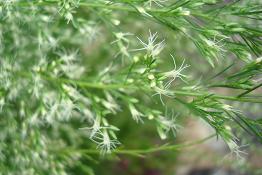| PlantID | 0065 |
| Botanical Name | Artemisia scoparia |
| Common Name | Wormwood |
| Classification | | Kingdom: | Plantae | | Subkingdom: | Tracheobionta | | Division: | Magnoliophyta | | Class: | Magnoliopsida | | Subclass: | Asteridae | | Order: | Asterales | | Family: | Asteraceae | | Genus: | Artemisia | | Species: | scoparia |
|
| Part used | Whole dried young plant |
| Medicinal Properties | Aromatic, purgative, slightly bitter and cold. |
| Medicinal Use | Useful to remove damp-heat, relieve jaundice, also used as infusion and in burns.
|
| Chemistry | Capillarisin, Chlorogenic acid butyl ester, 6,7-Dimethylesculetin, Isosabandin, Magnolioside (Isoscopoletin-Beta-D-glucopyranoside), 7-Methoxycoumarine, 7-Methylesculetin, Sabandins A, Sabandins B, Scoparone (6,7-dimethoxycoumarin), Scopoletin, Beta-Sitosterol.
|
| Cultivation | NA |
| Regional Habitat | Commonly found in the fallow fields, waste places and pasture-land in the rainy season. Distribution: Ganganagar, Churu, Jhunjhunu, Sikar, Jodhpur, Sirohi, Jaipur, Bharatpur and Sawai Madhopur districts of Rajasthan.
|
| Description | Erect, 1-1.5 m high, scenty herbs. Stem: sulcate, glabrescent, usually tinged with purple. Leaves: radical leaves are whorled; petiole 0.1-1.0 cm long; laminar segments linear, 0.5-1.0 cm long; cauline leaves filiform, 0.5-2.5 cm long, entire. Flowers: capitula 0.1-0.2 cm across, in terminal panicles; stalk 0.05-1.0 cm long; invol. bracts 3-4 striate, glistening; outer ones ovate-oblong, 0.08 cm long, obtuse; inner oblong, 0.2 cm long, apex obtuse; ray-florets 10 in number, 0.1 cm long, corolla 0.03 cm long, greenish-yellow; style slender, 2-fid; disc-florets 0.15 cm long, corolla 0.15 cm long, anthers 0.1 cm long, style 0.1 cm long. Fruits: cypsels oblong-ellipsoid, 0.03 cm long, smooth. Flowers and fruits appears during August-Februay.
|
| Image |  |


